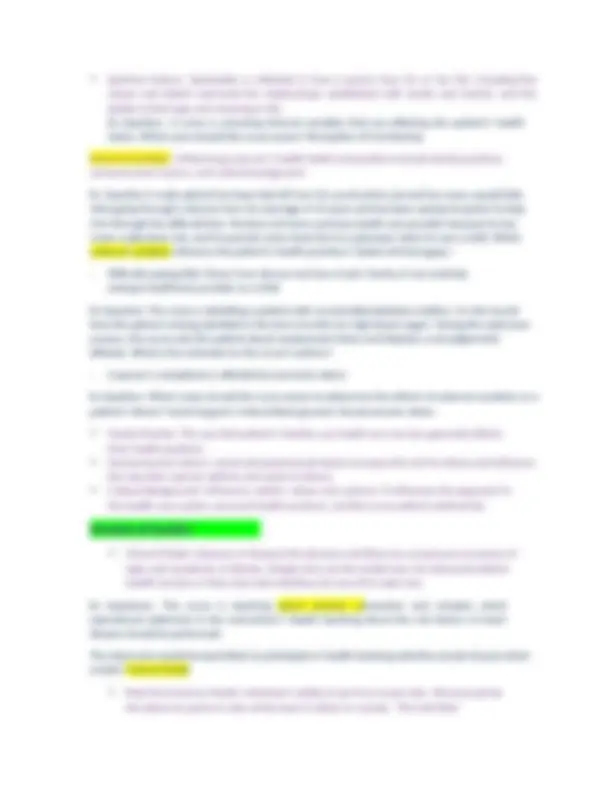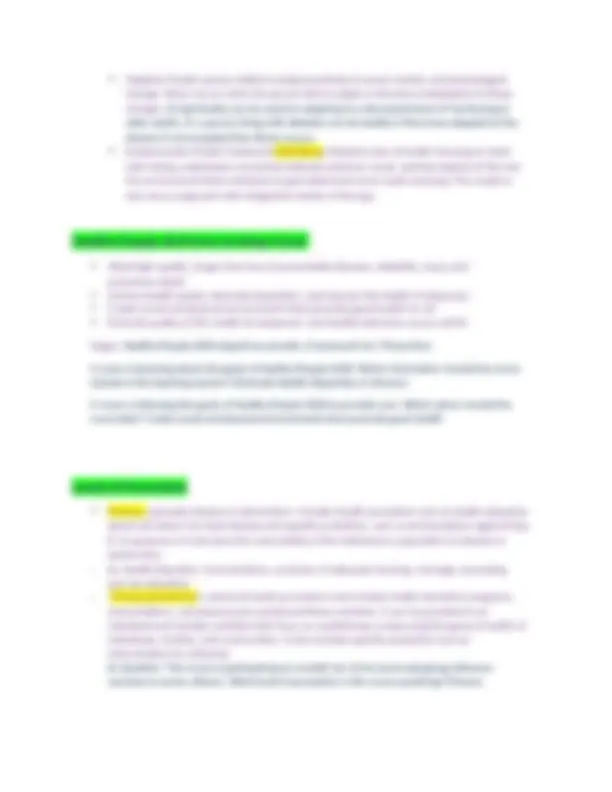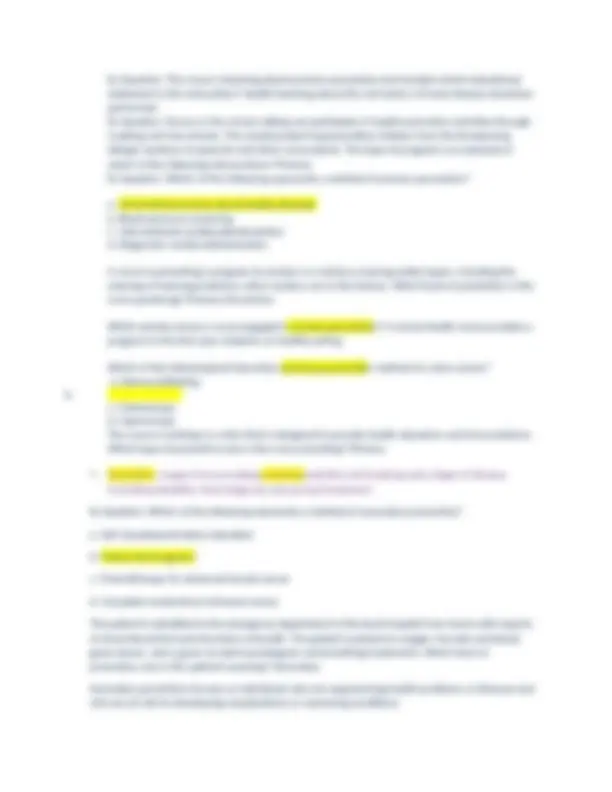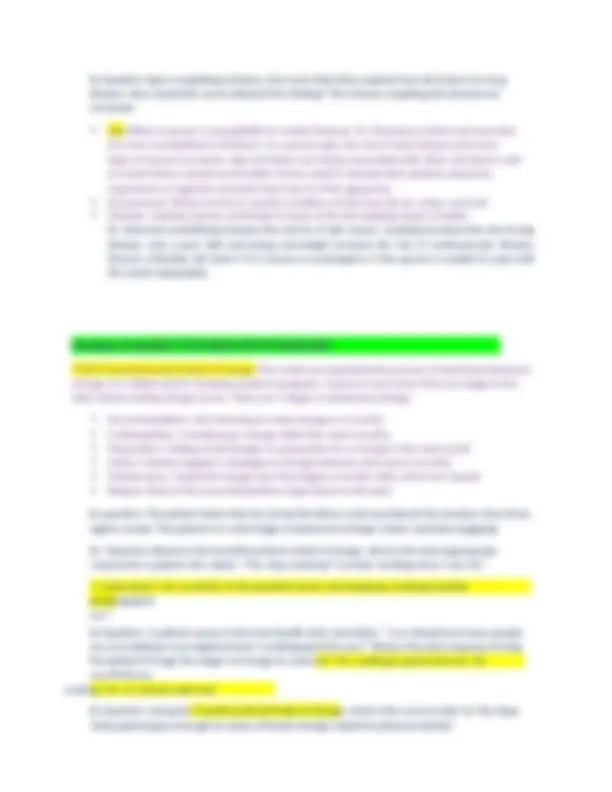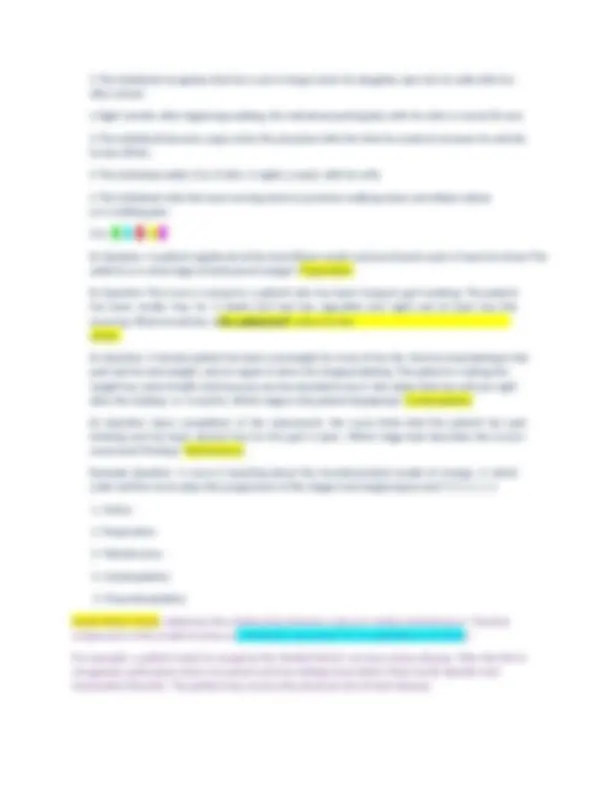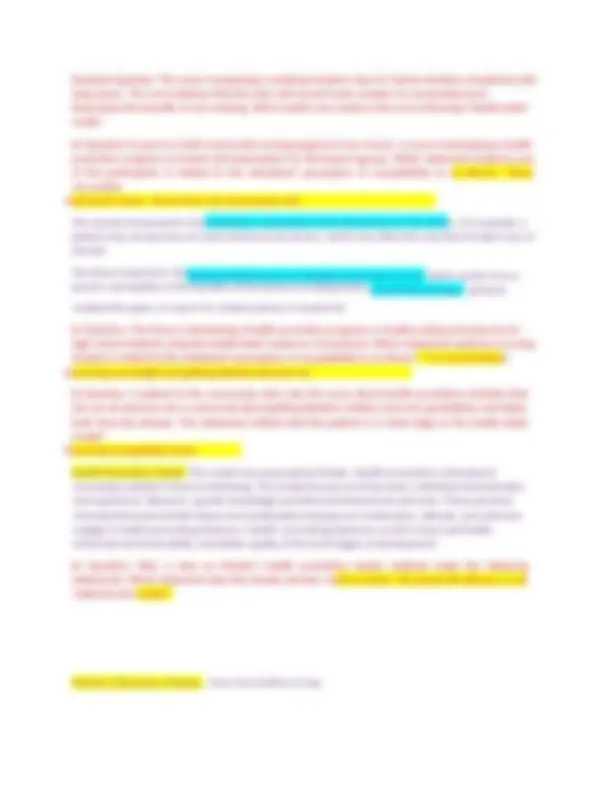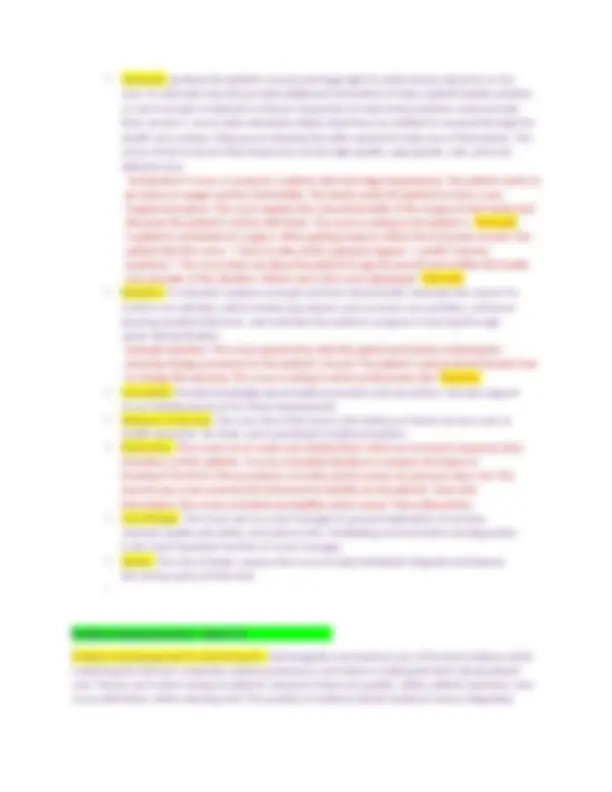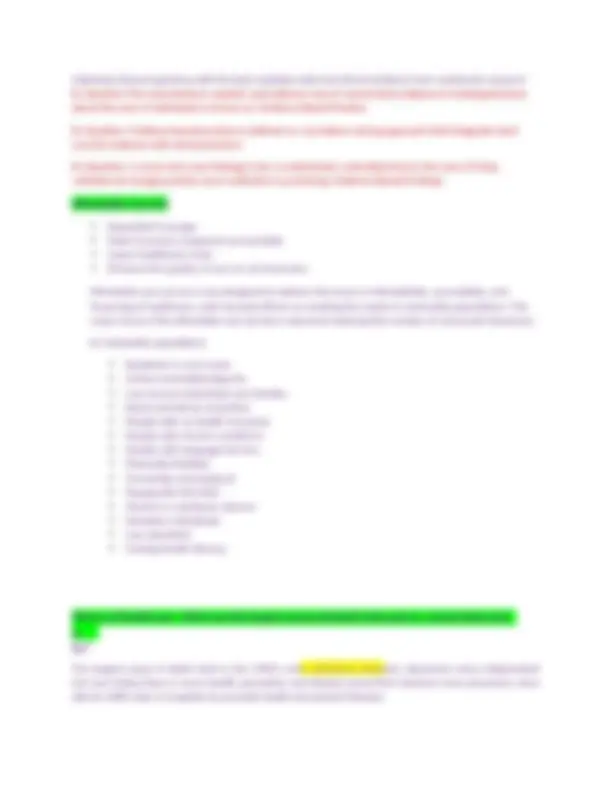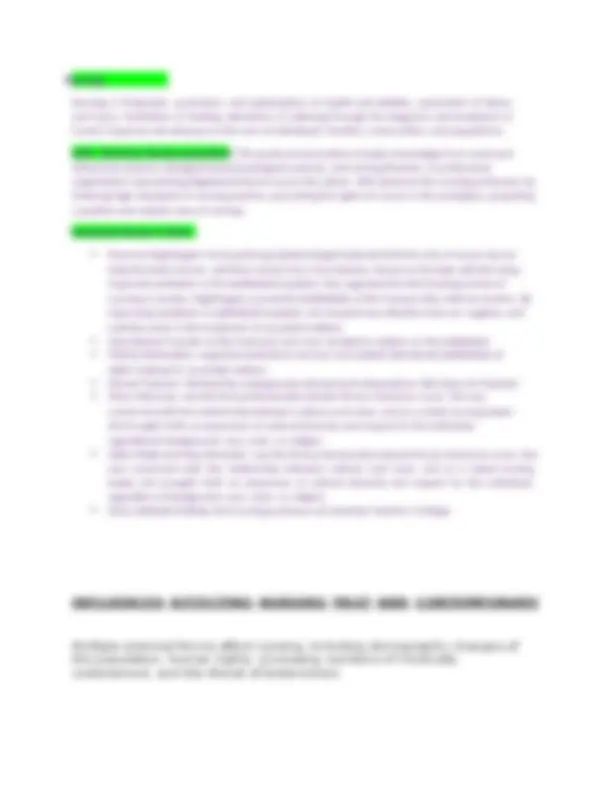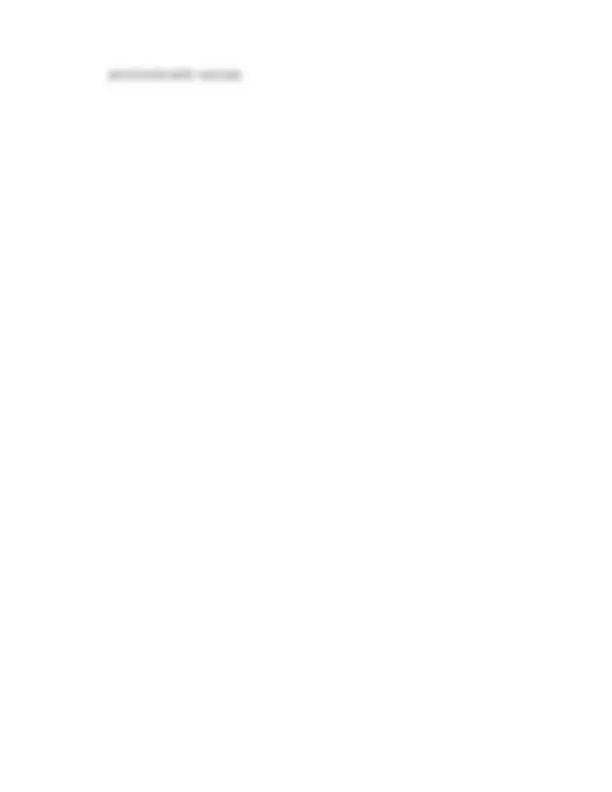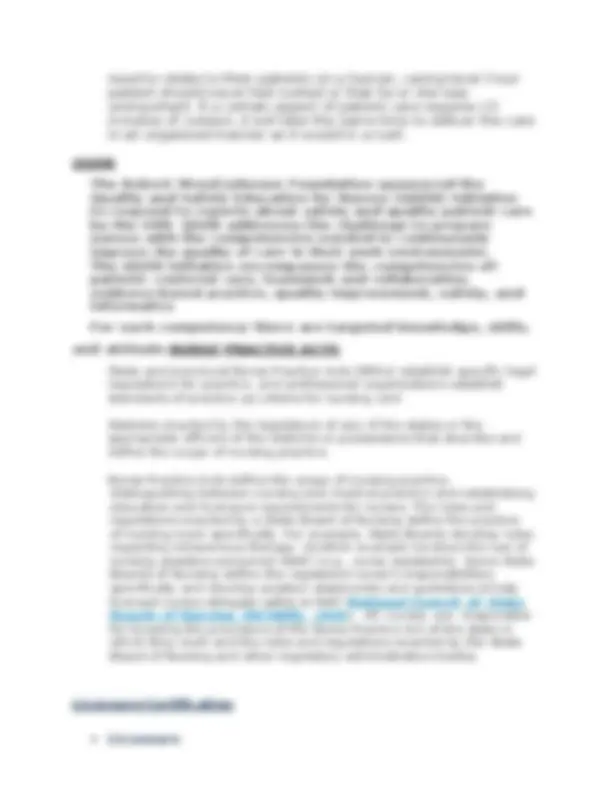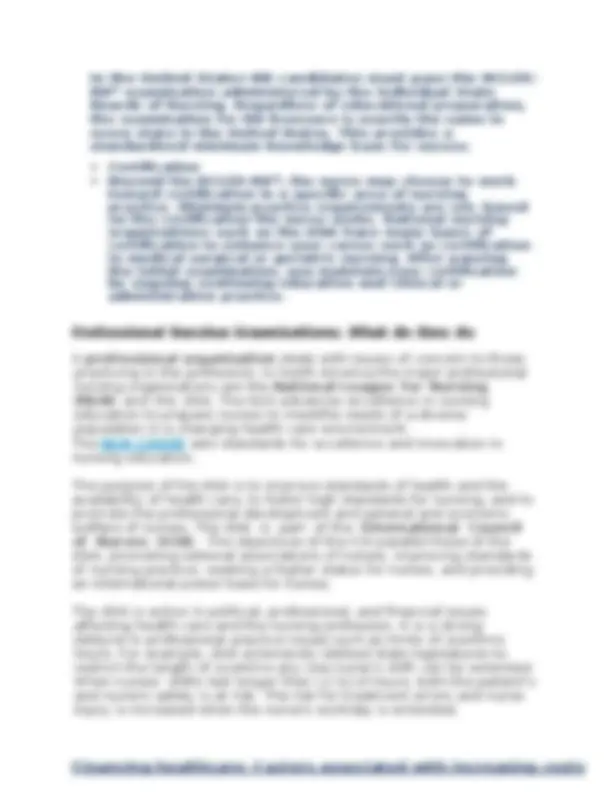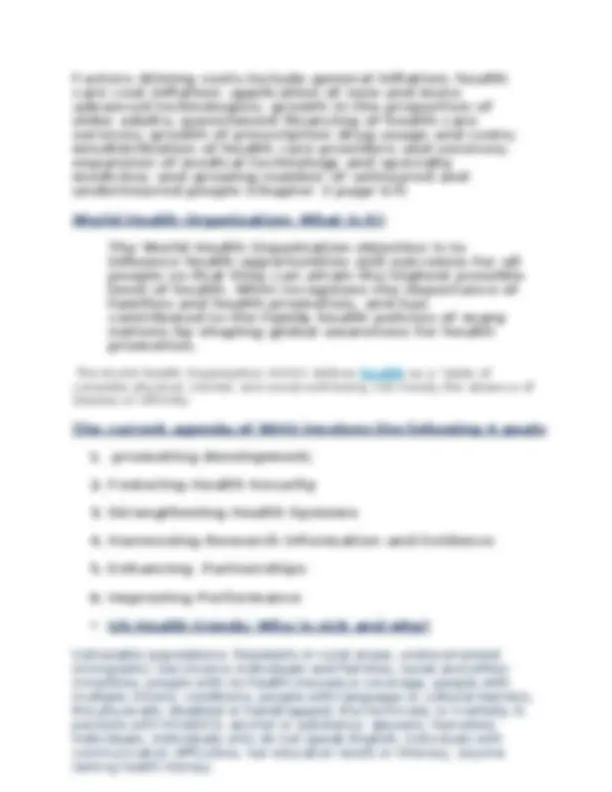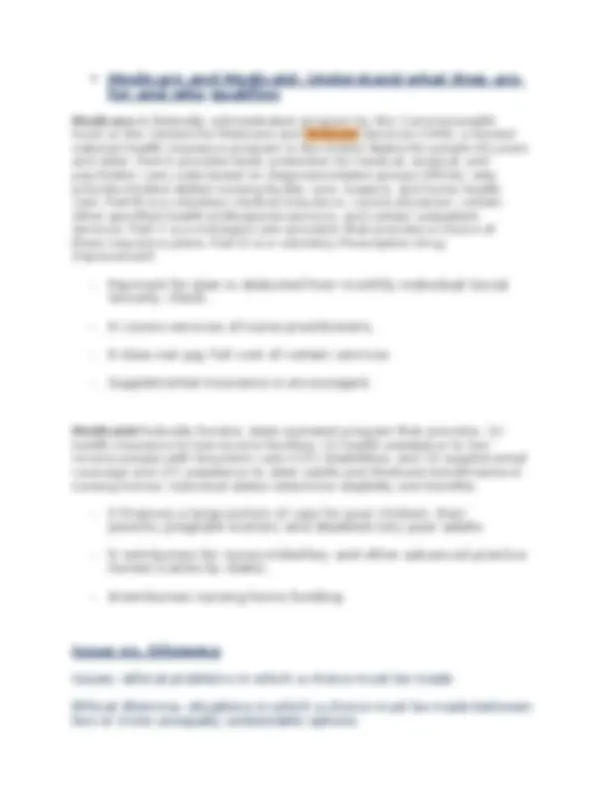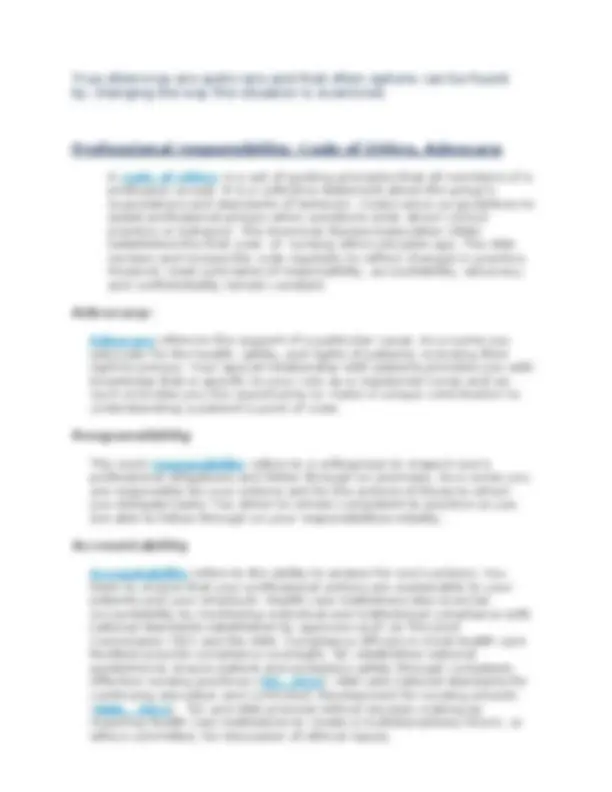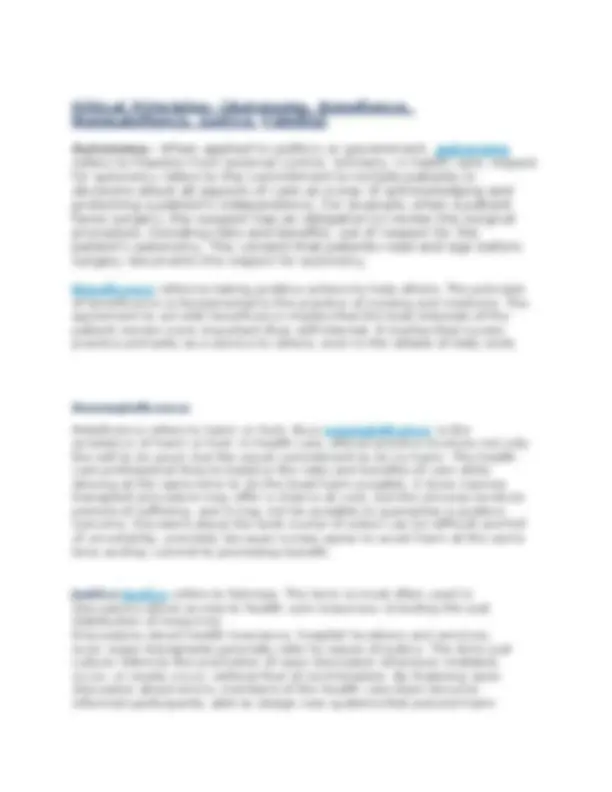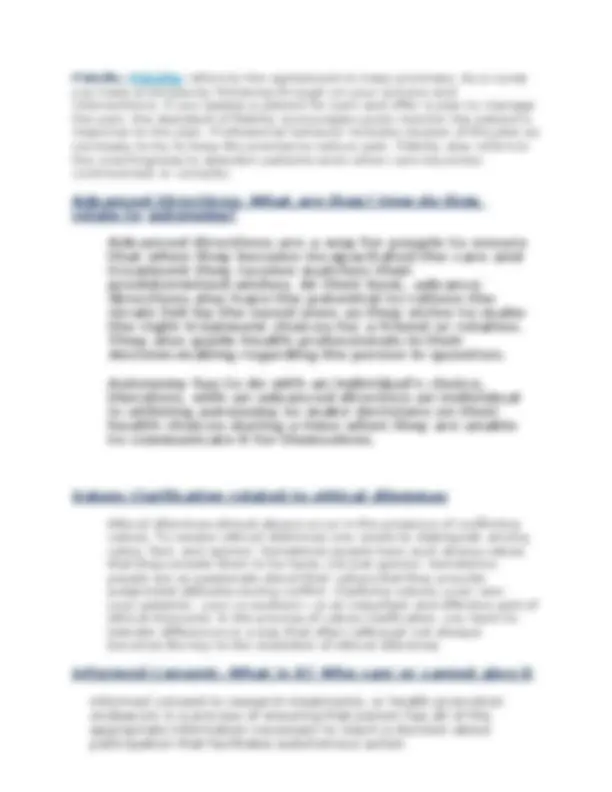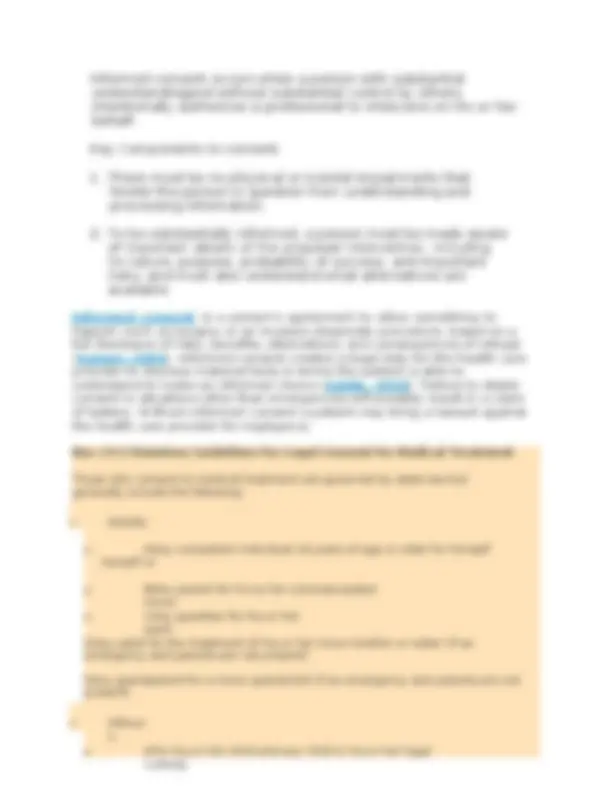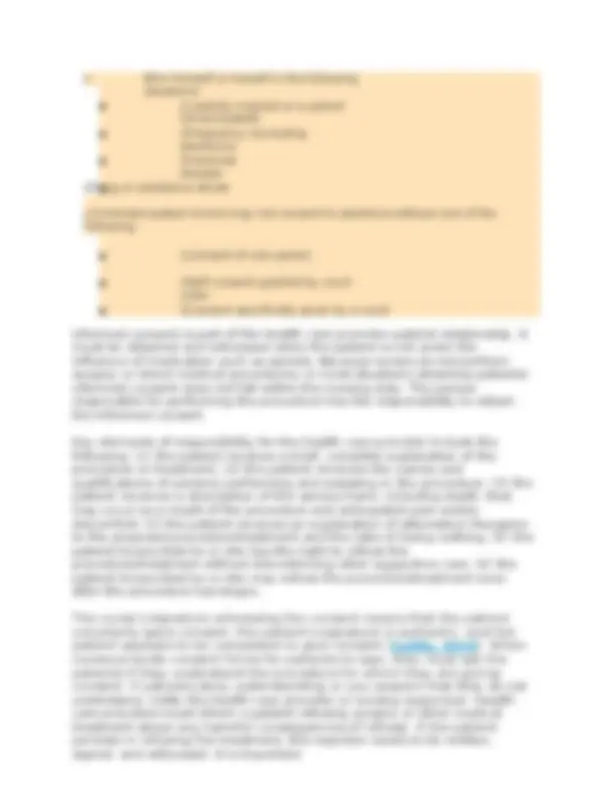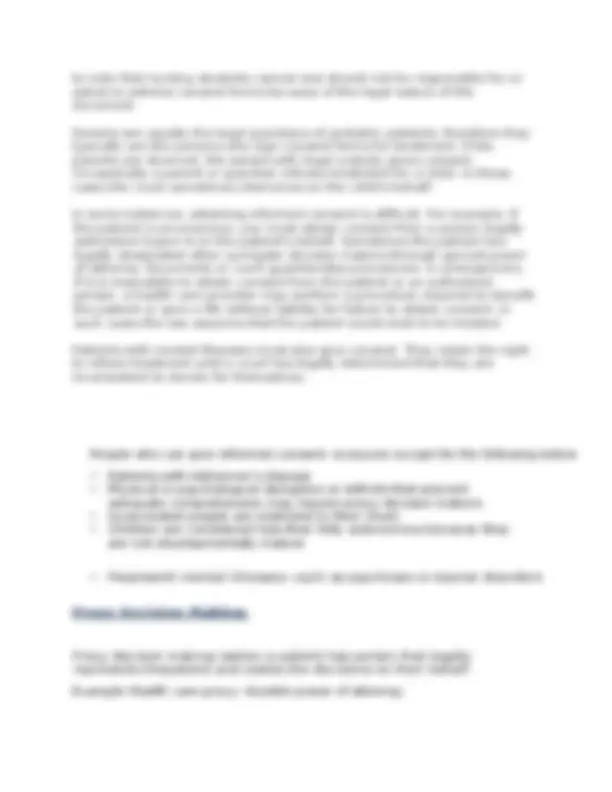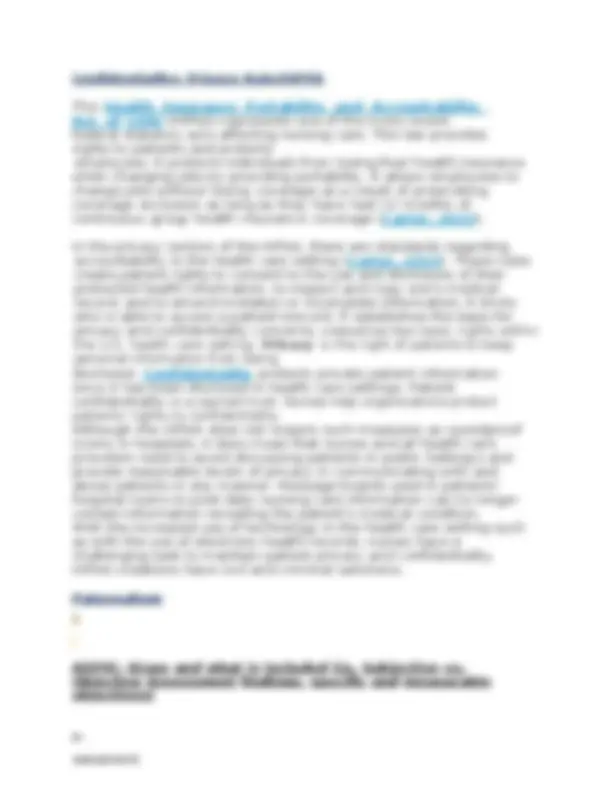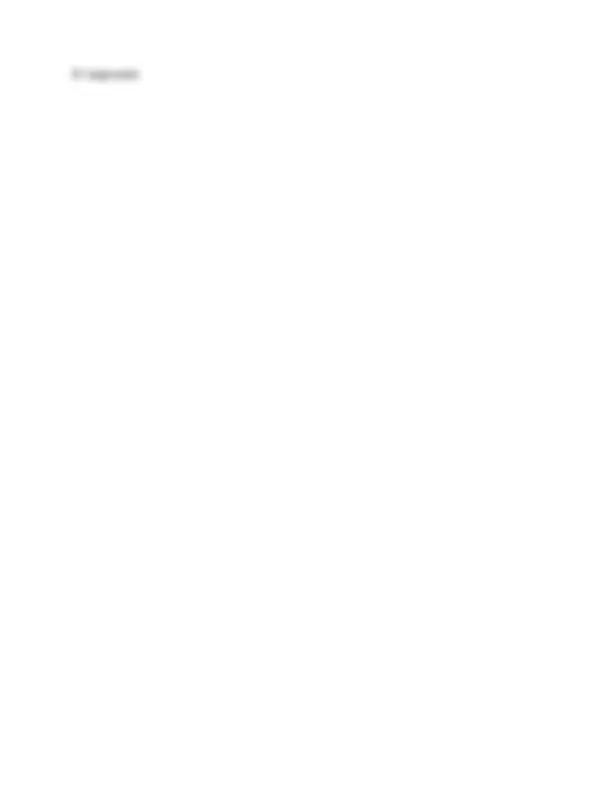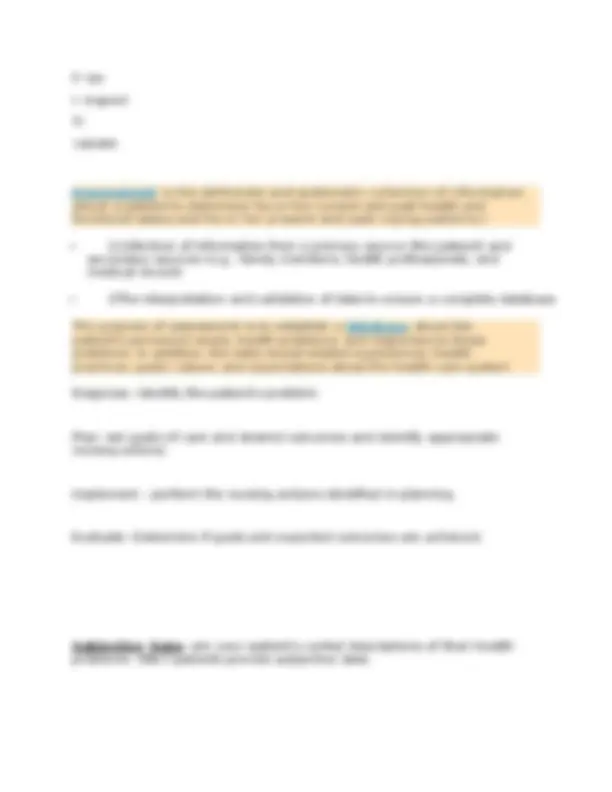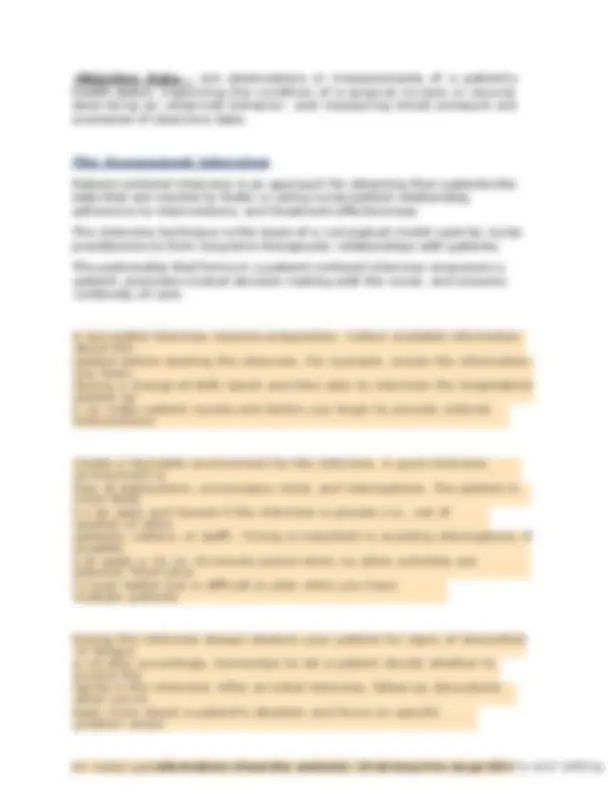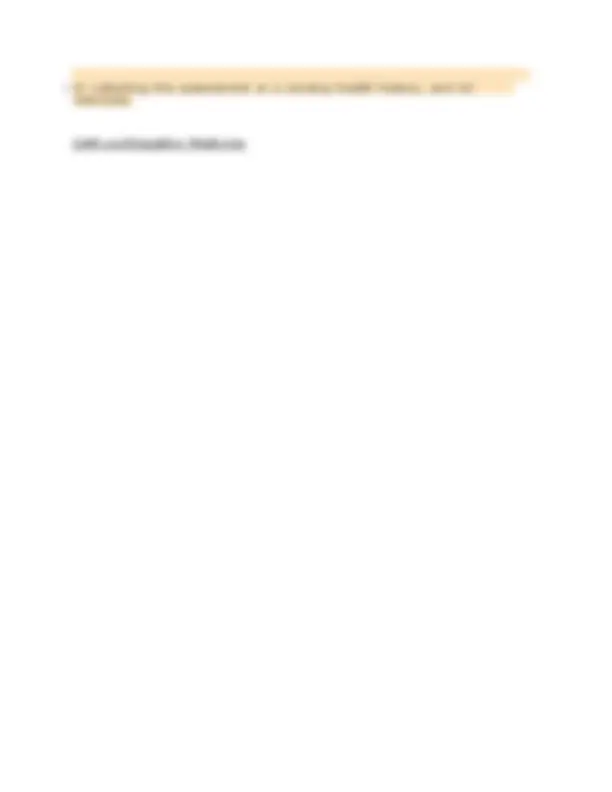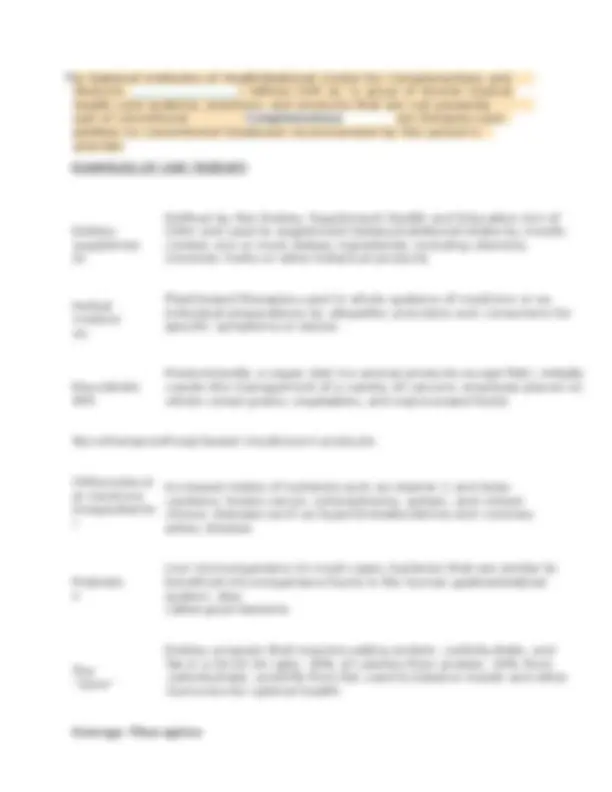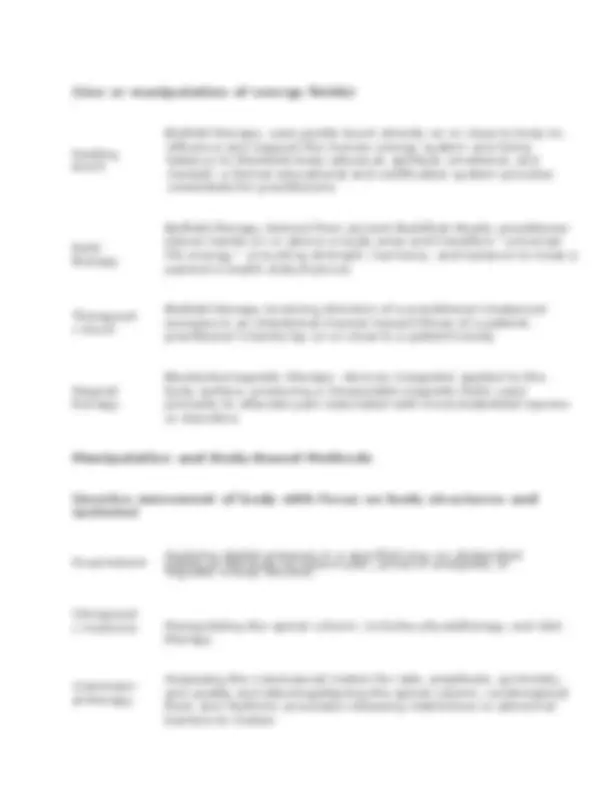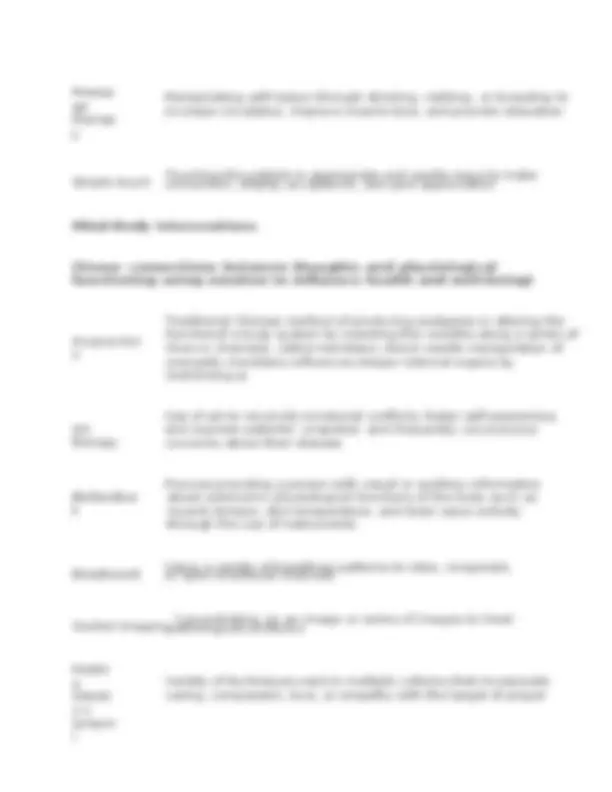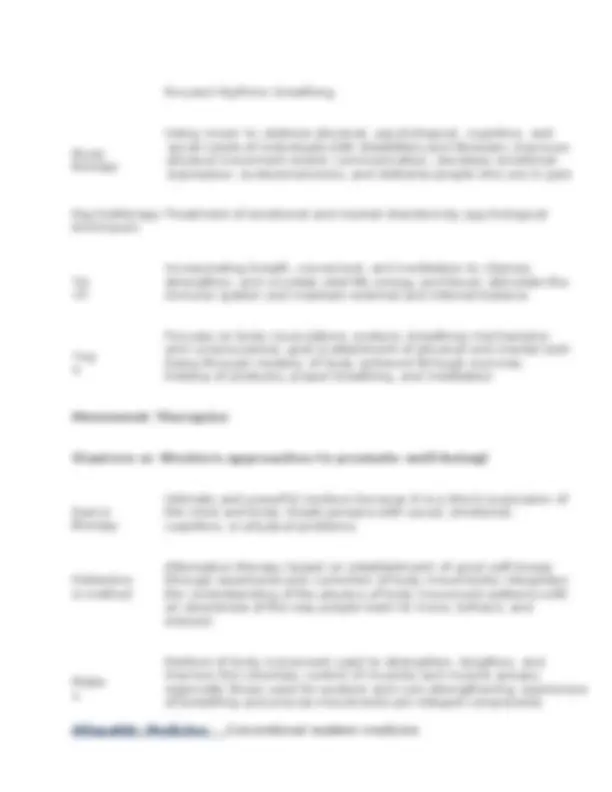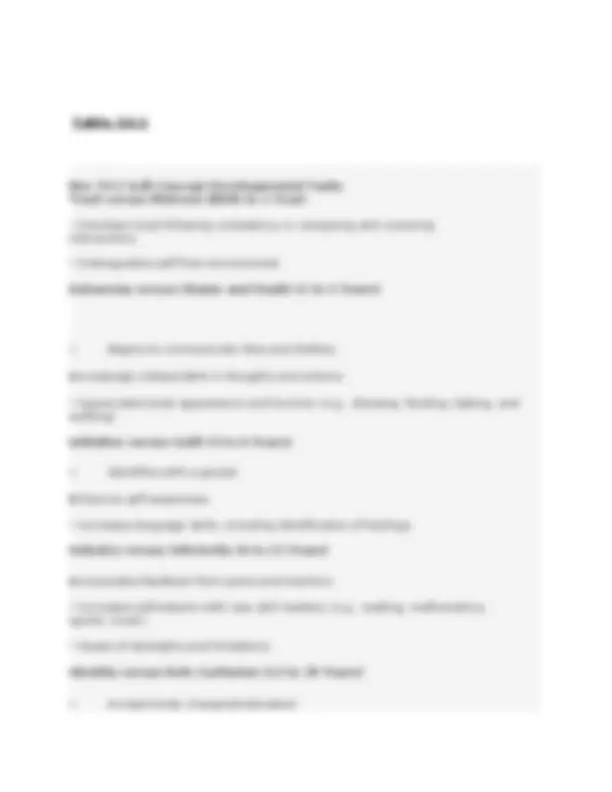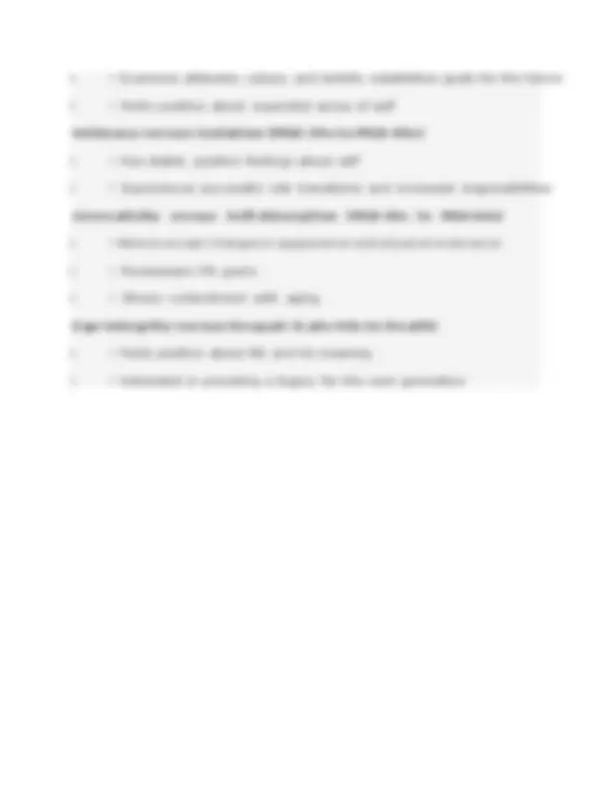Download NR 222 Exam 1 Study Guide (Question & Answers) 2022 and more Exams Nursing in PDF only on Docsity!
Definitionsiofihealth,ihealthipromotion,iillness,idiseas
e
NR 222 Exam 1 Study
Guide (Question &
Answers) 2022
Nurses Role in health and illness: Understands the challenges of today’s health care system/ Identifies actual and potential risk factors/ Experiences compassion fatigue Health Defined in text-is a state of physical, mental, spiritual, and social functioning that realizes a person’s potential and is experienced within the development context. Health is considered to be part of the metaparadigm for nursing, which includes the four components of person, health, environment, and nursing. Health encompasses spiritual, developmental, and environmental aspects over time. Health Defined by (WHO) is more consistent- The state of complete physical, mental, and social well- being and not merely the absence of disease and infirmity. Example: A person with diabetes maybe considered healthy if she is able to adapt to her illness and live a meaningful, spiritually satisfying life. Example Question: A state of physical, mental, spiritual, and social functioning that realizes a person’s potential and is experienced within a developmental context is known as: Health Ex Question: Health is considered to be a metaparadigm for nursing and includes which of the following components? (select all that apply) Person, Health, Environment, Nursing HealthiPromotion- The science and art of helping people change their lifestyle to move toward a state of optimal health. The process of advocating health to enhance the probability that personal (individual, family and community) private (professional and business) and public (federal, state and local government) Health promotion is also proactive decision making at all levels of society. Health promotion holds the best promise for lower-cost methods of limiting the constant increase in healthcare costs. Increasing a patient’s level of well-being within their environment to pursue health. Ex Questions: The nurse assesses a community for evidence of health-promotion strategies. Which of the following are health-promotion strategies? Self-Care for minor illness/Environmental changes to enhance clean air/Supporting Habitat for Humanity House Construction. Ex Question: Public health nurses are involved in supporting active health promotion strategies such as: Participating in an individual daily exercise program. Ex Question: Nurses in the school setting can participate in ihealthipromotioniactivities through creating nut-free schools. This would protect hypersensitive children from life-threatening allergic reactions to peanuts and other nut products. This type of program is an example of which of the following interventions? Primary Prevention Level which also ties into Health Promotion. Ex Question: Which of the following demonstrates a nurse taking action to promote health and prevent disease? Educating a person about the advantages of a heart-healthy diet during a home visit. Rationale: Solutions for health promotion are focused on individual and government involvement. To promote health and wellness, an emphasis must be placed on primary prevention. This is often relatedto actions such as education that influence lifestyle choices. In the preceding example, educating a
Illnessibehavior iRefor m
InternaliandiExternaliVariablesiinfluencingihealthibeliefsiandipractice
s
person about the advantages of a heart-healthy diet during a home visit serves to influence lifestyle choices. Ex Question: In addition to changes in ethnic and racial distribution within the population, it is expected that changes in distribution will affect health promotion practice. Answer: Age Illness- is a state in which a person’s physical, emotional, intellectual, social, developmental, or spiritual functioning is diminished or impaired. A person can have a disease without feeling ill and a person can also feel ill without having a diagnosable disease. Ex Question: Which of the following best describes a client who has an illness? Someone with a headache. Someone with a headache represents a person with an illness. An illness is made up of the subjective experience of the individual and the physical manifestation of disease. It can be described as a response characterized by a mismatch between a person’s needs and the resources available to meet those needs. A person can have a disease without feeling ill. Ex Question: When illness occurs, different attitudes about it cause people to react in different ways. What do medical sociologists call this reaction to illness? Disease- means without ease/ the failure of a person’s adaptive mechanisms to counteract stimuli and stresses adequately, resulting in functional or structural disturbances. Ex. Question Which of the following agencies or initiatives have been driving forces in and the prevention of iDisease in society? (select all that apply) Healthy People/ U.S. Department of Health, Education and Welfare/ U.S. Department of Health andHuman Services InternaliVariables- include aperson’s developmental stage, intellectual background, perception of functioning, and emotional and spiritual factors. Ex Question for Internal Variables: A nurse is assessing internal variables that are affecting the patient’s health status. Which area should the nurse assess? Perception of Functioning.
- Developmental stage- A Person’s thoughts and behavior patterns change throughout life. Emotional developmentmay also influence personal beliefs about health- relatedmatters.
- Intellectual Background- A person’s belief about health are shaped in part by a person’s knowledge, lack of knowledge or incorrect information about body functions and illnesses, educational background, and past experiences.
- Perception of functioning- The way people perceive their physical functioning affects health beliefs and practices. When accessing a patient’s level of health, you gather subjective data about the way the patient perceives physical functioning such as a level of fatigue, shortness of breath or pain. Objective data such as blood pressure, height measurements and lung sound assessments.
- Emotional Factors- The patient’s degree of stress, depression or fear can influence health belief and practices. HealthiCare
HealthyiPeoplei 2020 iOveriArchingi 4 iGoal
s
LevelsiofiPrevention
Primary iprevention
- Adaptive Model- person ability to adapt positively to social, mental, and physiological change. Illness occurs when the person fails to adapt or becomes maladaptive to these changes. Ex Spirituality can be useful in adapting to a decreased level of functioning in older adults. Or a person living with diabetes can be healthy if they have adapted to the disease if not accepted then illness occurs.
- Eudaimonistic Model- ExuberantiWell-Being /Patients view of health focusing on total well- being, emphasizes connection between physical, social, spiritual aspects of life and the environment that contribute to goal attainment and create meaning. This model is also more congruent with integrative modes of therapy.
- Attainhigh quality, longer lives free of preventable diseases, disability, injury and premature death.
- Achieve health equity, eliminate disparities, and improve the health of all groups
- Create social and physical environments that promote good health for all.
- Promote quality of life, health development, and healthy behaviors across all life stages. Healthy People 2020 objectives provide a framework for? Prevention A nurse is teaching about the goals of Healthy People 2020. Which information should the nurse include in the teaching session? Eliminate Health Disparities in America A nurse is following the goals of Healthy People 2020 to provide care. Which action should the nurse take? Create social and physical environments that promote good health.
- Primary- precedes disease or dysfunction. Includes health promotion such as health education about risk factors for heart disease and specific protection, such as immunizations against Hep B. Its purpose is to decrease the vulnerability of the individual or population to disease or dysfunction.
- Ex. Health Education, immunizations, provision of adequate housing, marriage counseling and sex education
- is aimed at health promotion and includes health-education programs, immunizations, and physical and nutritional fitness activities. It can be provided to an individual and includes activities that focus on maintaining or improving the general health of individuals, families, and communities. It also includes specific protection such as immunization for influenza. Ex Question: The nurse is participating at a health fair at the local mall giving influenza vaccines to senior citizens. What level of prevention is the nurse practicing? Primary
Ex Question: The nurse is teaching about primary prevention and includes which educational statement in the instructions? Health teaching about the risk factors of heart disease should be performed. Ex Question: Nurses in the school setting can participate in health promotion activities through creating nut-free schools. This would protect hypersensitive children from life-threatening allergic reactions to peanuts and other nut products. This type of program is an example of which of the following interventions? Primary Ex Question: Which of the following represents a method of primary prevention? a. b. Blood pressure screening c. Interventional cardiaccatheterization d. Diagnostic cardiaccatheterization A nurse is presenting a program to workers in a factory covering safety topics, including the wearing of hearing protectors when workers are in the factory. Which level of prevention is the nurse practicing? Primary Prevention Which activity shows a nurse engaged in iprimaryiprevention? A school health nurse provides a program to the first-year students on healthy eating. Which of the following best describes aiprimaryiprevention method for colon cancer? a. Hemocculttesting c. Colonoscopy d. Laparoscopy The nurse is working in a clinic that is designed to provide health education and immunizations. Which type of preventive care is the nurse providing? Primary
- Secondary- ranges from providingiscreening activities and treating early stages of disease to limiting disability. Early diagnosis and prompt treatment. Ex Question: Which of the following represents a method of secondary prevention? a. Self–breastexamination education b. c. Chemotherapy for advanced breast cancer d. Complete mastectomy forbreast cancer The patient is admitted to the emergency department of the local hospital from home with reports of chest discomfort and shortness of breath. The patient is placed on oxygen, has labs and blood gases drawn, and is given an electrocardiogram and breathing treatments. Which level of preventive care is this patient receiving? Secondary Secondary prevention focuses on individuals who are experiencing health problems or illnesses and who are at risk for developing complications or worsening conditions. Informationalisessioniaboutihealthyilifestyle s ib. iHighifiberidiet Yearlyimammograms
SpecificiProtection
RiskiFactors
Genetic iand iPhysiological iFactors- Active Strategies- depend on the individual becoming personally involved in adopting a proposed program of health promotion. Examples of lifestyle change are performing daily exercise as a part ofa physical fitness plan and adopting stress management program as apart of daily living. Ex Question: Public health nurses are involved in supporting active health promotion strategies suchas: A. supporting cleanwater. B. advocating for vitamin D in all milk. C. supporting sanitary sewage systems. D. Protecting people from injury and disease, examples would be providing immunizations and reducing exposure to occupational hazards, carcinogens and other environmental health risks. Immunization for influenza is quite popular and has become a regular activity for people ask risk each fall. Nurses can participate in this specific protection role by giving influenza injections in clinics and offices. Definition: Any situation, habit, social or environmental condition, physiological or psychological condition, developmental or intellectual condition, spiritual condition, or other variable that increases the vulnerability of an individual or group to an illness or accident. Risk factors increase the chances that the individual will experience a particular disease or dysfunction. Risk factors play a major role in how a nurse identifies a patient’s health status. Risk Factors are often placed in interrelated categories:
- involves the physical functioning of the body. Physical conditions such as being pregnant or overweight place increase stress on physiological systems increasing susceptibility to illness. Ex. A person with a family history of diabetes mellitus is at risk for developing the disease later in life. Genetic and physiological risk factors include those related to hereditary, genetic predisposition to an illness, or those that involve physical functioning of the body. Ex Question: The nurse assesses the following risk factors for coronary artery disease (CAD) in afemale patient. Which factors are classified as genetic and physiological? (Select all that apply.) Mother Died from CAD at age 48/ History of Hypertension/ Elevated Cholesterol level participatingiinianiindividualidailyiexerciseiprogram .
yi ou?” “I iunderstand. iCan iyouithink iof ithe igreatestireason iwhyistopping ismokingiwouldibe ichallengingifor
ModelsiofiHealthiTTM/HBM/HPM/MASLOW/
HOLISTIC/SOCIALiCOGNITIVE
TTMCi(TranstheoreticaliModeliofiChange ) Ex Question Upon completing a history, the nurse finds that a patient has risk factors for lung disease. How should the nurse interpret this finding? The chances of getting the disease are increased.
- Age affects a person’s susceptibility to certain illnesses. Ex. Premature infants and neonates are more susceptible to infections. As a person ages, the risk of heart disease and many types of cancers increases. Age risk factors are closely associated with other risk factors such as family history and personal habits. Nurses need to educate their patients about the importance of regularly schooled check-ups for their age group.
- Environment- Where we live in and the condition of that area (its air, water, and soil)
- Lifestyle- Lifestyle choices contribute to seven of the ten leading causes of death. Ex. Excessive sunbathing increases the risk for of skin cancer, smoking increases the risk of lung disease, and a poor diet and being overweight increase the risk of cardiovascular disease. Stressis a lifestyle risk factor if it is severe or prolonged or if the person is unable to cope with life events adequately. This model conceptualizesthe process of intentional behavior change. It is widely used in smoking cessation programs. A person must move from one stage to the other before lasting change occurs. There are 5 stages of behavioral change:
- Precontemplation- Not intending to make change in 6 months
- Contemplation- Considering a change within the next 6 months
- Preparation- Making small changes in preparation for a change in the next month
- Action- Actively engage in strategies to change behavior lasts up to 6 months.
- Maintenance- Sustained change over time begins 6 months after action has started
- Relapse- Back to the precontemplation stage (back to old ways) Ex question: The patient states that she joined the fitness club and attends the aerobics class three nights a week. The patient is in what stage of behavioral change? Action (actively engaging) Ex. Question: Based on the transtheoretical model of change, what is the most appropriate responseito a patient who states: “Me, stop smoking? I’ve been smoking since I was 16!” Ex Question: A patient comes to the local health clinic and states: “I’ve noticed how many people are out walking in my neighborhood. Is walking good for you?” What is the best response to help the patient through the stages of change for exercise? iYes, iwalking iis igreat iexercise. iDo iyou ithinkiyou Ex Question: Using theiTranstheoreticaliModeliofiChange, what is the correct order for the steps thata patient goes through to make a lifestyle change related to physical activity? couldigo ifor iai 5 - minute iwalkinext iweek?”
Likeilifestyleichanges ilikelihoodithatitheipersoniwillitakeipreventativeiaction Health iPromotioniModel- Example Question: The nurse is preparing a smoking cessation class for family members of patients with lung cancer. The nurse believes that the class will convert many smokers to nonsmokersonce theyrealize the benefits of not smoking. Which health care model is the nurse following? Health belief model Ex Question As part of a faith community nursing program in her church, a nurse is developing a health promotion program on breast self-examination for thewomen’sgroup. Which statement made by one of the participants is related to the individual’s perception of susceptibility to an illness? i“Since imy imother The second component is the individual’s iperception iofithe iseriousness iof ithe iillness. For example, a patient may not perceive his heart disease to be serious, which may affect the way that he takes care of himself. The third component- the person’s perception of the benefits of the barriers to taking action. i medical therapies, or search for medical advice or treatment. which results from a , going to Ex Question: The Nurse is developing a health promotion program on healthy eating and exercise for high school students using the health belief model as a framework. Which statement made by a nursing student is related to the individual’s perception of susceptibility to an illness? i“I’m iworriediabout Ex Question: A patient at the community clinic asks the nurse about health promotion activities that she can do because she is concerned about getting diabetes mellitus since her grandfather and father both have the disease. This statement reflects that the patient is in what stage of the health belief model? This model was proposed by Pender. Health promotion is directed at increasing a patient’s level of well-being. This model focuses on three areas; individual characteristics and experience. Behavior; specific knowledge and affect and behavioral outcomes. These personal characteristicsinteractwith theenvironmenttodetermineaperson’smotivation, attitude, and actionsto engage in health promoting behaviors. Health- promoting behaviors result in improved health, enhanced functional ability, and better quality of life at all stages of development. Ex Question: After a class on Pender’s health promotion model, students make the following statements. Which statement does the faculty member need to clarify? iPerceived iself-efficacy iis inot irelated itoithe model.” Goes from bottom to top ihadibreast icancer,iIiknowithat iIiamiatiincreased irisk iforidevelopingibreasticancer.” becomingioverweightiand igetting idiabetesibecauseimy ifatherihasidiabetes”. Perceivedisusceptibilityitoithe idisease. Maslow’siHierarchyiofiNeeds
SafetyiandiSecurity Basic human needs are elements that are necessary for human survival and health. This is a model that nurses use to understand the interrelationships of basic human needs. According to this model, certain human needs are more basic than others. Fulfilling the physiological needs before the need of love and belonging. For example, in a house fire fear of injury and death takes priority over self- esteem issues.
- Physiological- Breathing, food, water, sleep.
- Safety-Security ofbody, family, health
- Love/Belongings- friendship/family /intimacy
- Esteem- confidence/ self-esteem/ respect from others
- Self-actualization- morality/ problem solving/ creativity /discovery of self Ex Question: A nurse is conducting a home visit with an older-adult couple. While in the home the nurse weighs each individual and reviews the 3 -day food diary with them. She also ichecksitheiribloodipressure and encourages them toiincrease itheirifluids and activity levels to help with their voiced concern about constipation. The nurse is addressing which level of need according to Maslow? Physiological Rationale: The nurse’s actions address the basic physiological needsof nutrition, fluids, elimination, and oxygen. According to Maslow, basic needs must be met before meeting higher level needs. Ex Question: A nurse is conducting a home visit with an older-adult couple. While in the home the nurse weighs each individual and reviews the 3-day food diary with them. She also checks their blood pressure and encourages them to increase their fluids and activity levels to help with their voiced concern about constipation. The nurse is addressing which level of need according to Maslow? Example Question: A nurse is using Maslow’s hierarchy to prioritize care for an anxious patient that is not eating and will not see family members. Which area should the nurse address first?
Evidenceibasedipractice/ iwhatiisiit
iandihowiweiuseiit
Problemisolvingiapproachitoiclinicalipractic e
- Advocate- protects the patient’s human and legal right to make choices about his or her care. An advocate may also provide additional information to help a patient decide whether or not to accept a treatment or find an interpreter to help family members communicate their concerns. nurses help individuals obtain what they are entitled to received through the health care systems. Help person develop the skills required to take care of themselves. The nurse strives to ensure that all persons receive high-quality, appropriate, safe, and cost- effective care. Ex Question A nurse is caring for a patient with end-stage lung disease. The patient wants to go home on oxygen and be comfortable. The family wants the patient to have a new surgical procedure. The nurse explains the risk and benefits of the surgery to the family and discusses the patient’s wishes with them. The nurse is acting as the patient’s: iAdvocate A patient is scheduled for surgery. When getting ready to obtain the informed consent, the patient tells the nurse, “I have no idea what is going to happen. I couldn’t ask any questions.” The nurse does not allow the patient to sign the permit and notifies the health care provider of the situation. Which role is the nurse displaying? iAdvocate
- Educator- An educator explains concepts and facts about health, describes the reason for routine care activities, demonstrates procedures such as home care activities, reinforces learning orpatient behavior, and evaluates the patient’s progress in learning through return demonstration. Example Question: The nurse spends time with the patient and family reviewing the dressing change procedure for the patient’s wound. The patient’s spouse demonstrates how to change the dressing. The nurse is acting in which professional role? Educator
- Consultant- Provide knowledge about health promotion and prevention. Provide support on an individual level of for future development
- Delivereriofiservices- The core role of the nurse is the delivery of direct services such as health education, flu shots, and counseling in health promotion.
- Researcher- The nurses on an acute care medical floor notice an increase in pressure ulcer formation in their patients. A nurse consultant decides to compare two types of treatment.The first is the procedure currently used to assess for pressure ulcer risk. The second uses ainew assessment instrument to identify at-risk patients. Given this information, the nurse consultant exemplifies which career? Nurse Researcher
- CareiManger- The nurse acts as a care manager to prevent duplication of services, maintain quality and safety, and reduce costs. Facilitating communication among parties is the most important function of a care manager.
- Healer- The role of healer requires the nurse to help individuals integrate and balance the various parts of their lives
- that integrate conscientious use of the best evidence while combining the clinician’s expertise, patient preference, and values in making decisions about patient care. Nurses use it when caring for patients, because it improves quality, safety, patient outcomes, and nurse satisfaction while reducing costs The practice of evidence-based medicine means integrating
wi
hy?
Historyiofihealthcare: iWhatiwasitheilargesticausesiofideathiinitheipastivs.icausesitodayiand
AffordableiCareiAct
individual clinical expertise with the best available external clinical evidence from systematic research. Ex Question The conscientious, explicit, and judicious use of current best evidence in making decisions about the care of individuals is known as: Evidence Based Practice Ex Question: Evidence-based practice is defined as: A problem-solving approach that integrates best current evidence with clinical practice Ex Question: A nurse who uses findings from a randomized, controlled trial on the care of Foley cathetersito change practice at an institution is practicing: Evidence Based Findings
- Expanded Coverage
- Hold Insurance companies accountable
- Lower healthcare Costs
- Enhance the quality of care for all Americans Affordable care act was a law designed to address the issues of affordability, accessibility, and financing of healthcare, with focused efforts on meeting the needs of vulnerable populations. The major focus of the affordable care act law is aimed at reducing the number of uninsured Americans. Ex Vulnerable populations
- Residents in rural areas
- Undocumentedimmigrants
- Low-income individuals and families
- Racial and ethnic minorities
- People with no health insurance
- People with chronic conditions
- People with language barriers
- Physically disabled
- Terminally ormentally ill
- Peoplewith HIV/AIDs
- Alcohol or substance abusers
- Homeless individuals
- Low education
- Lacking health literacy The largest cause of death back in the 194 0’s were iinfectious idiseases/ physicians were independent but now today there is more health promotion and disease prevention because more physicians were able to fulfill roles in hospitals to promote health and prevent disease.
iincreasing. i This i is ia i group i of i patients iwhose i physical i status i does i not Todayinursesiandischoolsiofinursingiareidevelopingipartnershipsit oiimprove
- Health care reform Health care reform not only affects how health care is paid for but how it is delivered. There will be greater emphasis on health promotion, disease prevention, and illness management in the future. This model impacts the delivery of nursing care. More services will be in community-based care settings. As a result, more nurses will be needed to practice in community care centers, schools, and senior centers. This will require nurses to be more adept at assessing for resources, service gaps, and how the patient adapts toreturning to the community. Nursing must respond to such changes by exploring new methods to provide care, changing nursing education, and revising practice standards - Demographic Changes The U.S. Census Bureau (2008a) predicts that between 2010 and 2050 there will be a steady rise in the population. This change alone requires expanded health care resources. Add to the population change a steady increase in the population of people 65 years and older ( U.S. Census Bureau, 2008b ). To effectively meet all the health care needs of the expanding and aging population, changes need to occur as to how care is provided, especially in the area of public health, to address health care reform and meet the needs of the changing population. The population is still shifting from rural areas to urban centers, and more people are living with chronic and long-term illness ( Presley, 2010 ). Not only are there expansionsof outpatient settings, but more and more people want to receive outpatient and community-based care and remain in their homes or community **- Medically Underserved
- Threat of Bioterrorism** iunderserved ipatients iwho irequire ihome-based ipalliative icare iservices iis . iIn ithe iUnited iStates isome iof ithe imedically iunderserved ipopulation iare ipoor iprovide iand ipay ifor ithese iservices ei conomic ifactors iof ia icountry iaffect iboth iaccess ito icare iand iresources ito imedically iunderserved ipopulation iis ia iglobal iissue; ithe isocial, ipolitical, iand ti o iincreases iin ithe imedically iunderserved ipopulation. iCaring ifor ithe imental iillness, i and ihomelessness i and irising i health i care i costs i all i contribute The irising irates iof iunemployment, iunderemployment i and ilow-paying ijobs, iand ion iMedicaid. iOthers iare ipart iof ithe iworking ipoor i(i.e., ithey iicannotheir iot (^) wiafnf oiinsurancerd , ibut ithey imake itoo imuch imoney ito iqualify ifor iiManedd iiasca idia iresult ido inot ireceive iany ihealth icare). iIn iaddition, ithe inumber iof i improveiand iheath icare ineeds iincrease. iAs ia iresult, ithe icost ifor ihome-based icar e icontinues ito irise, ito ithe ipoint ithat isome ipatients iopt iout iof iall ipalliative health ioutcomes iin iunderserved icommunities. iNurses iwork iiinco (^) mithmeseunity-based isettings iproviding ihealth ipromotion iiaprndeven idisteionas eito ithe ihomeless, imentally iill, iand iothers iwho ihave ilimited tiaci^ ocihessealth^ icare^ ior^ iwhoilackihealth^ icare iinsurance iservices ibecause iof icos
The world is a changing place; the threats of bioterrorism are continuous. Many health care agencies, schools, and communities have educational programs to prepare for nuclear, chemical, or biological attack. Nurses are active in disaster preparedness. The ICN works alongside national nursing associations to determine how to best educate and prepare nurses for future disasters (. For example, public health emergency simulation exercises allow nurses and students to work with community disaster-preparedness groups and hospitals todetermine what specific nursing activities are needed These activities sometimes range from participation in vaccine research, decontamination in the event of biological attack, and triage for mass casualty to crisis response units. If a disaster were to occur, nurses would be essential in evaluating the strengths and weaknesses of any disaster plan Rising Health Care Cost Skyrocketing health care costs present challenges to the profession, consumer, and the health care delivery system. As a nurse you are responsible for providing the patient with the best-quality care in an efficient and economically sound manner. The challenge is to use health care and patient resources wisely. Nursing Shortage
There is an ongoing global nursing shortage, which results from
insufficient qualified registered nurses (RNs) to fill vacant
positions and the loss of qualified RNs to other professions
This shortage affects all aspects of nursing such as patient
care, administration, and nursing education (but it also
represents challenges and opportunities for the profession.
Many health care dollars are invested in strategies aimed at
recruiting a well-educated, critically thinking, motivated, and
dedicated nursing workforce). There is a direct link between
registered nurses' care and positive patient outcomes, reduced
complication rates, and a more rapid return of the patient to an
optimal functional status.
Professional nursing organizations predict that there will continue
to beia diminishing pipeline of RNs in the future (Like it or not,
the nursing shortage affects the needs of the consumer (With
fewer nurses in the workplace, it is important for you to learn to
use your patient contact time efficiently and professionally.
Time management, therapeutic communication, patient
education, and compassionate implementation of psychomotor
skills are just a few of the essential skills you need.
Most important, your patients leave the health care setting with
a positive image of nursing and a feeling that they received
quality care. In a rapid-discharge and high-tech health care
need to relate to their patients on a human, caring level (Your
patient should never feel rushed or that he or she was
unimportant. If a certain aspect of patient care requires 15
minutes of contact, it will take the same time to deliver the care
in an organized manner as it would in a rush
QSEN
The Robert Wood Johnson Foundation sponsored the Quality and Safety Education for Nurses (QSEN) initiative to respond to reports about safety and quality patient care by the IOM. QSEN addresses the challenge to prepare nurses with the competencies needed to continuously improve the quality of care in their work environments. The QSEN initiative encompasses the competencies of: patient- centered care, teamwork and collaboration, evidence-based practice, quality improvement, safety, and informatics For each competency there are targeted knowledge, skills, and attitude NURSE PRACTICE ACTS State and provincial Nurse Practice Acts (NPAs) establish specific legal regulations for practice, and professional organizations establish standards of practice as criteria for nursing care Statutes enacted by the legislature of any of the states or the appropriate officers of the districts or possessions that describe and define the scope of nursing practice. Nurse Practice Acts define the scope of nursing practice, distinguishing between nursing and medical practice and establishing education and licensure requirements for nurses. The rules and regulations enacted by a State Board of Nursing define the practice of nursing more specifically. For example, State Boards develop rules regarding intravenous therapy. Another example involves the use of nursing assistive personnel (NAP) (e.g., nurse assistants). Some State Boards of Nursing define the registered nurse's responsibilities specifically and develop position statements and guidelines toihelp licensed nurses delegate safely to NAP ( National Council of State Boards of Nursing [NCSBN], 2005 ). All nurses are responsible for knowing the provisions of the Nurse Practice Act of the state in which they work and the rules and regulations enacted by the State Board of Nursing and other regulatory administrative bodies Licensure/Certification
- Licensure
In the United States RN candidates must pass the NCLEX- RN®^ examination administered by the individual State Boards of Nursing. Regardless of educational preparation, the examination for RN licensure is exactly the same in every state in the United States. This provides a standardized minimum knowledge base for nurses.
**- Certification
- Beyond the NCLEX-RN®, the nurse may choose to work** toward certification in a specific area of nursing practice. Minimum practice requirements are set, based on the certification the nurse seeks. National nursing organizations such as the ANA have many types of certification to enhance your career such as certification in medical surgical or geriatric nursing. After passing the initial examination, you maintain your certification by ongoing continuing education and clinical or administrative practice. Professional Nursing Organizations: What do they do
A professional organization deals with issues of concern to those
practicing in the profession. In North America the major professional
nursing organizations are the National League for Nursing
(NLN) and the ANA. The NLN advances excellence in nursing
education to prepare nurses to meetthe needs of a diverse
population in a changing health care environment.
The NLN (2008) sets standards for excellence and innovation in
nursing education.
The purpose of the ANA is to improve standards of health and the
availability of health care, to foster high standards for nursing, and to
promote the professional development and general and economic
welfare of nurses. The ANA is part of the International Council
of Nurses (ICN). The objectives of the ICN parallel those of the
ANA: promoting national associations of nurses, improving standards
of nursing practice, seeking a higher status for nurses, and providing
an international power base for nurses.
The ANA is active in political, professional, and financial issues
affecting health care and the nursing profession. It is a strong
lobbyist in professional practice issues such as limits of overtime
hours. For example, ANA extensively lobbied state legislatures to
restrict the length of overtime any one nurse's shift can be extended.
When nurses’ shifts last longer than 12 toi 16 hours, both the patient's
and nurse's safety is at risk. The risk for treatment errors and nurse
injury is increased when the nurse's workday is extended.
Financing healthcare: Factors associated with increasing costs

